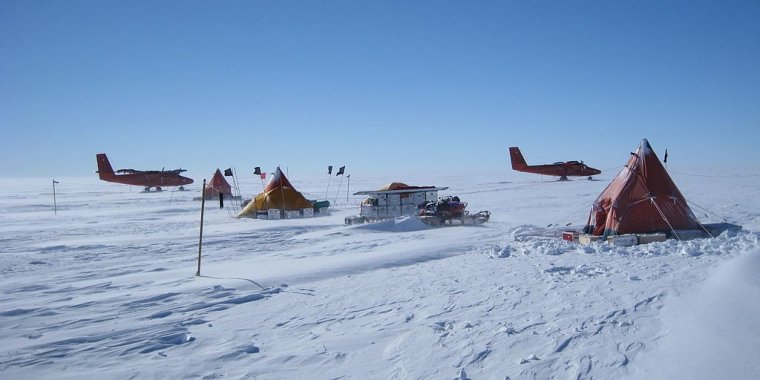| News / Science News |
West Antarctica's largest glacier may have started retreating as early as the 1940s
The present-day thinning and retreat of Pine Island Glacier, one of the largest and fastest shrinking glaciers of the West Antarctic Ice Sheet, may have already been underway as early as the 1940s, according to findings from an international research team led by the British Antarctic Survey (BAS).

British Antarctic Survey fieldcamp on Pine Island Glacier. ![]()
"Pine Island Glacier is one of the most inhospitable and remote areas of Antarctica, so to get all the equipment needed to hot-water drill through the ice shelf required a major effort from our collaborators at the U.S. Antarctic Program," said James Smith, a marine geologist with BAS. "On the ground it was a real team effort to lower the drill by hand to the seabed on nearly 1,000 meters of rope. After all that work, the fact that the cores show us something so unexpected and important is a great feeling."
The fate of the West Antarctic Ice Sheet is a major concern to scientists.
Pine Island Glacier has thinned and retreated at an alarming rate since 1992, when satellite observations first started. The ice lost from this and neighboring glaciers has added significantly to sea level rise, and this area is one of biggest single unknowns in future projections of global sea level rise.
Until now, scientists did not know when the retreat of Pine Island Glacier started, or its underlying cause.
In the BAS study, scientists obtained seabed sediment cores from beneath the floating part of Pine Island Glacier, which revealed a cavity had formed beneath the shelf prior to the mid-1940s. This allowed warm seawater to flow under the shelf, causing it to lift off from the prominent sea floor ridge that held it in place.
The finding strongly suggests that warming of the region associated with El Niño activity initiated the current retreat.
Smith noted the sediment cores, which were obtained through a 450-meter deep hole in the ice and up to 500 meters of ocean, showed how changes halfway around the world in the tropical Pacific could influence the Antarctic ice sheet.
Scientists participating in workshops in the U.S. and U.K. in the past year acknowledged that the future activity of the glacier is an unknown and a potential major concern. The enormous ice sheet holds enough water to produce the equivalent of more than 9 feet (3 meters) of global sea level rise. (NSF)
YOU MAY ALSO LIKE



